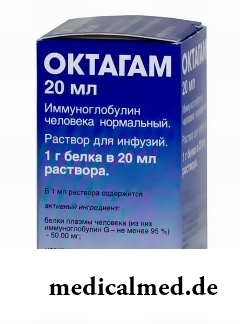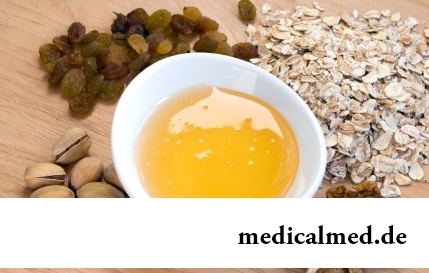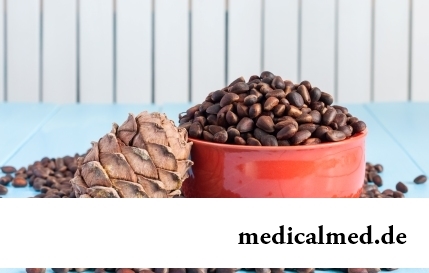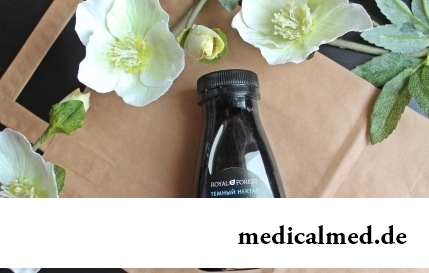





Octadin
Application instruction:
 Octadin – the drug of normal immunoglobulin (class G) containing the wide range of antibodies to causative agents of infections of various etiology intended for recovery of level of immunoglobulin G to a normal indicator, having immunomodulatory properties.
Octadin – the drug of normal immunoglobulin (class G) containing the wide range of antibodies to causative agents of infections of various etiology intended for recovery of level of immunoglobulin G to a normal indicator, having immunomodulatory properties.
Form of release and structure
Dosage form of Oktagam – solution for infusions: transparent or slightly opalescent liquid from colourless till light yellow color (in glass bottles on 20, 50, 100 or 200 ml of solution, on 1 bottle in a pack cardboard).
Structure of 1 ml of solution:
- Active ingredient: a plasma protein – 0,05 g (including immunoglobulin G (IgG) not less than 95%);
- Auxiliary components: a maltose, октоксинол, tributyl phosphate, water for injections.
Indications to use
Octadin is applied as drug of replacement therapy at the following states / diseases:
- Primary immunodeficient syndromes: Glantsmana-Riniker's syndrome (alymphocytosis, heavy combined immunodeficience), hereditary hypogammaglobulinemia (inborn agammaglobulinemia), Viskotta-Aldrich's syndrome, variable generalized immunodeficience;
- The Chronic Lymphocytic Leukoses (CLL) or multiple myeloma complicated by recurrent infections and a heavy secondary hypogammaglobulinemia;
- The inborn human immunodeficiency virus (HIV) at children complicated by recurrent infections.
Indications for Oktagam's use as immunomodulatory drug:
- The Idiopathic Werlhof's Disease (IWD) or Verlgof's disease at children and adults at high risk of bleeding or before an operative measure (for the purpose of correction of quantity of thrombocytes);
- Acute polyradiculoneuritis (syndrome to Giyena-Barra);
- Disease of Kawasaki (acute children's feverish skin mucous лимфожелезистый syndrome);
- Allogenic transplantation of marrow.
Contraindications
Absolute contraindication to Oktagam's use are hypersensitivity to his components and hypersensitivity or intolerance of homologous immunoglobulins, in particular it is (extremely rare) at deficit of immunoglobulin A (IgA), in case of existence at the patient of antibodies to IgA.
Intake of immunoglobulin in a blood stream relatively increases viscosity of blood, increasing risk of development of a stroke, myocardial infarction, a deep vein thrombosis, thromboembolism of a pulmonary artery. In this regard drug with care is used at obesity and existence of the following factors contributing to development of trombotichesky complications: advanced age, a heavy hypovolemia, arterial hypertension, vascular pathologies, a diabetes mellitus, tendency to a thrombogenesis, the long immobilization, a syndrome of the increased viscosity of blood and a disease promoting a pachemia.
Due to the risk of development of an acute renal failure it is required to be careful, using immunoglobulin intravenously at a diabetes mellitus, excess weight, a hypovolemia, a renal failure, at advanced age (after 65 years), and also to the patients accepting nefrotoksichny drugs along with IgG. In case of the first symptoms of an acute renal failure it is necessary to cancel drug immediately.
The patient from risk group of development of tromboembolic episodes and an acute renal failure Oktagam enter in the smallest efficient doses with the minimum speed.
Clinical experience of therapy by drugs of immunoglobulins proves that their use has no significant negative effect on the course of pregnancy, fetation and a condition of the newborn. But as safety of use of drug for pregnant women was not confirmed during controlled clinical trials, during pregnancy and in the period of a lactation (breastfeeding) drug is appointed with care.
Route of administration and dosage
The drug is administered intravenously.
It is necessary to follow the following rules for Oktagam's introduction:
- To register the name of drug and number of a series in the medical record or a case history that there was an opportunity to monitor communication of a condition of the patient with administration of solution from a specific series;
- To check solution regarding lack of a deposit and opacification; it has to be transparent, slightly opalescent or colourless (the containing deposits and muddy solutions are forbidden to be used);
- To bring solution temperature to room;
- To use for infusion the initial speed of 0,01-0,02 ml on body weight kg a minute not less than 30 minutes; at good tolerance of drug it is possible to increase speed gradually, as much as possible – to 0,12 ml by body weight kg a minute;
- The drug which remained after infusion (in any quantity) is required to be destroyed.
The mode of dosing and duration of a course of therapy are individually selected by the attending physician depending on indications, response clinical reaction and pharmacokinetic data of the specific patient.
The recommended dosing:
- Replacement therapy of primary immunodeficient syndromes: an initial dose of 0,4-0,8 g/kg of body weight with further introduction of 0,2 g/kg of 1 times to 3 weeks; the monthly dose of 0,2-0,8 g/kg is necessary for achievement of concentration of 6 g/l; on reaching an equilibrium state it is required to maintain an interval between infusions of 2-4 weeks. For correction of the mode of dosing it is necessary to take measurement of concentration of IgG before each following infusion (the mode of administration of drug has to guarantee achievement of concentration of IgG measured before each subsequent infusion, at least within 4-6 g/l that is reached for 3-6 months from the beginning of therapy);
- Replacement therapy at a multiple myeloma and HLL complicated by recurrent infections with a secondary hypogammaglobulinemia and inborn HIV infection at children: To 0,2-0,4 g/kg there are each 3-4 weeks;
- Immunomodulatory therapy of ITP: acute episodes – 0,8-1 g/kg in the first day, if necessary – repeated introduction in the same dose for the third day, or for 2-5 days on 0,4 g/kg; in case of a recurrence therapy is repeated;
- Immunomodulatory therapy of a syndrome to Giyena-Barra (acute polyradiculoneuritis): 0,4 g/kg a day for 3-7 days; experience of use in pediatric practice is limited;
- Immunomodulatory therapy at a disease of Kawasaki: 1,6-2 g/kg enter in the equal doses divided for 2-5 days or carry out single introduction of 2 g/kg of body weight; the concomitant use of acetylsalicylic acid is recommended;
- Allogenic transplantation of marrow (drug is used as one of components of preparatory therapy against infectious complications and after transplantation for prevention of development of a syndrome "a transplant against the owner"): doses select individually, the recommended initial – 0,5 g/kg a week, it is necessary to begin reception in 1 week prior to transplantation, course duration – 3 months after transplantation; at constant deficit of immunoglobulins it is necessary to enter 0,5 g/kg before normalization of an indicator of level of immunoglobulins once a month.
Side effects
- Circulatory and lymphatic system: very seldom – hemolysis, reversible hemolitic anemia, a leukopenia;
- Respiratory system: very seldom – an embolism of a pulmonary artery, respiratory insufficiency, a fluid lungs, an asthma, cough, a bronchospasm;
- Digestive tract: often – nausea; very seldom – an abdominal pain, vomiting, diarrhea;
- Immune system: often – allergic reactions; very seldom – anaphylactic and anaphylactoid reactions (including an acute anaphylaxis), a face edema, a Quincke's edema (angioneurotic);
- Integuments: infrequently – eczema; very seldom – rash (including erythematic), urticaria, dermatitis, an alopecia, an itch;
- Musculoskeletal device: infrequently – a dorsodynia; very seldom – a mialgiya, an arthralgia;
- Urinary system: very seldom – increase in concentration in creatinine blood, an acute renal failure;
- Nervous system: often – a headache; very seldom – aseptic meningitis, disturbances of cerebral circulation (including a stroke), excitement, dizziness, migraine, paresthesia;
- Cardiovascular system: very seldom – tachycardia, heartbeat, a myocardial infarction, a circulatory unefficiency, cyanosis, thrombosis, hypertensia, hypotension, a deep vein thrombosis;
- Laboratory indicators: very seldom – increase in values of liver enzymes, false positive increase in concentration in glucose blood;
- Another: often – reactions in the place of an injection, fatigue, fever; infrequently – a stethalgia, a fever; seldom – sharp decrease AP (arterial pressure); very seldom – a hyperthermia, rushes of blood to the person, a hyperhidrosis, an indisposition; in isolated cases – an acute anaphylaxis (including patients who transferred administration of immunoglobulin without complications earlier).
Classification of frequency of undesirable reactions:> 1%-<10% – are frequent;> 0,1%-<1% – infrequently; <0,01% – are very rare.
Development of side effects of intravenous administration of immunoglobulins depends on a dose of drug and speed of its introduction.
Symptoms of overdose of Oktagam are increase in density of blood, in particular at elderly patients or patients with a renal failure, and also a delay in a water organism. In case of overdose symptomatic therapy is recommended.
Special instructions
In the course of IgG injection Oktagam is required to control a condition of the patient.
The patients receiving immunoglobulins intravenously prior to infusion should carry out adequate hydration, to exercise control of a diuresis and content of serumal creatinine, to exclude the diuretics operating on renal tubules.
Introduction of high doses of immunoglobulin can promote increase in viscosity of a blood plasma that strengthens risk of tromboembolic episodes and ischemia. Most often side reactions arise at high rate of administering, at agamma-and gipoglobulinemiya (with deficit of IgA or without it), at primary administration of immunoglobulin or, occasionally, upon transition to other immunoglobulins, and also after a long break from the moment of the last infusion.
The first infusion needs to be carried out slowly, rate of administering should not exceed 0,016 ml/kg/min. More careful observation is necessary for patients who did not receive immunoglobulin drugs earlier, received treatment by alternative drugs, or at a long break since the last infusion of immunoglobulin. Control throughout all first introduction and within an hour after its termination is necessary for these patients. Other patients are enough to be observed the first 20 minutes of infusion.
Tranzitorny increase in blood of passively postponed antibodies can be the cause of false positive results of serological tests.
Passive transfer to erythrocyte antigens of antibodies, for example, of A, B or D, can lead to falsification of results of some serological tests with erythrocyte alloantibodies (for example, Koombs's tests), to influence quantity of a gaptoglobin and reticulocytes.
Content in solution of a maltose can influence laboratory indicators of quantity in blood and urine of glucose.
When using drugs it is impossible to exclude from human blood or plasma completely probability of infection with various activators, including earlier unknown.
In the course of production of IgG Oktagam observe the following measures which are directed to an exception of transfer of viruses by transfusion environments:
- Selection of healthy donors is made, every portion of plasma and a plasma pool passes test for existence of antibodies to HIV 1 and 2, antigen of a virus of hepatitis B, hepatitis C;
- Fractions of plasma are analyzed on genetic material of a virus of hepatitis C;
- Process of production of medicine included special procedures for a removal/inactivation of viruses with use of system of cleaning solvent/detergent which efficiency is confirmed with tests on virus model.
These measures are effective for a removal/inactivation of HIV infection and viruses of the hepatitis B and C, but can have limited action in relation to casing-free viruses, for example hepatitis A and a parvovirus of B19.
Medicinal interaction
Octadin can reduce efficiency of live vaccines of attenuirovanny strains of viruses of the following diseases for 1,5-3 months: measles, smallpox, rubella, epidemic parotitis, chicken pox. Therefore it is necessary to sustain a break not less than 3 months between use of drug and performing vaccination by live attenuirovanny vaccines. For a vaccine against measles such effect can be preserved till 1 year therefore before vaccination against measles check of a caption of protivokorevy antibodies is required.
Terms and storage conditions
To store in the dark place, unavailable to children, at a temperature of 2-25 °C. Not to freeze!
Period of validity:
- Bottles of 20 ml – 1,5 years;
- Bottles of 50, 100 and 200 ml – 2 years.
Name of drug
Price
Drugstore
Antidepressant Klomipramin causes an orgasm in 5% of patients.

The business lady, the become mother, it is necessary to solve an array of problems. But of them is main: how to combine the beloved child and work?...
Section: Slideshow
Healthy lifestyle today in fashion, and many parents think of that the child from the early childhood played sports. Trainings will help it to become strong and hardy, will improve coordination of movements, and also will exert positive impact on mentality: it...
Section: Articles about health
Let's begin with the fact that a separate illness which is called "adjournment of salts", just does not exist. In practice this household name of disbolism leading to development of a number of diseases. Pathological process consists that in an organism there is an accumulation of salts of uric acid (as a rule, owing to failure of a water salt metabolism or insufficiently effective work of secretory system)....
Section: Articles about health
Partial and the more so full loss of hearing significantly reduces quality of life. Difficulties with communication lead to loneliness and замкн...
Section: Articles about health
The naturopathy sometimes moves as the new direction of medicine, something like fashionable hobby, and there is nothing farther from the truth. This most ancient direction, the word "naturopathy" is translated as "treatment by the nature", and, no doubt, treatment приро...
Section: Articles about health
The majority of gynecologic diseases prove three main signs, each of which speaks about need of a visit to the gynecologist. Certainly, it is possible to establish the exact diagnosis only after inspection, but on the basis of some signs it is possible to assume existence of this or that pathology. Let's consider symptoms of the female diseases which are found most often....
Section: Articles about health
Separate food - the system of meal based on digestion physiology which is carried to improvement methods. In opinion д...
Section: Articles about health
Color of plants is caused by presence at them of certain chemical compounds. Let's talk about what is meant by various colors of vegetables and fruit and what properties they give them....
Section: Articles about health
Life expectancy in various regions of Earth is not identical. Social stability, economic wellbeing, availability and level of medical care, household comfort, literacy of the population in the field of respect for sanitary and hygienic norms and many other factors exert impact on it. However one parameter remains to the general almost for all countries of the world: women on average live for 7-10 years longer, than men. Today we will talk about the reasons of this phenomenon....
Section: Articles about health
Health and attractiveness - eternal values, pursuing which people often use the most unusual ingredients and technicians...
Section: Articles about health
What they, women? Beautiful, gentle, passionate and at the same time windy, gusty, and nervous. And what is stranger: have all these qualities of the woman at the same time. But here only the mood their time sharply changes on completely opposite: in the morning...
Section: Articles about health
High temperature - a frequent symptom of such widespread diseases as a SARS, quinsy, pneumonia, etc. To reduce heat, having facilitated a condition of the patient, doctors recommend to accept antipyretics, however their use is not always possible. Too frequent use of these drugs can lead to allergic reactions, and also overdose, causing poisoning. It happens also that there are no antipyretics simply in the house. In these situations it is pertinent to use it...
Section: Articles about health
So, you resolved to lose weight. And now you try to understand what to begin with: from exercise stresses or a diet? And how to make, h...
Section: Slideshow
Cystitis, or inflammation of a mucous membrane of a bladder, this very widespread disease which, owing to some features of a structure of bodies of urinogenital system, women have approximately four times more often than men. In the main risk group...
Section: Articles about health
The Genetically Modified Organisms (GMO) are plants or animals (as a rule, agricultural) to whose genotype purposeful changes were made. Opposition of supporters and opponents of inclusion of such organisms in foodstuff always was very acute. Not only scientists and dietitians, but also a large number of the people who are not specialists in this question are involved in active disputes today....
Section: Articles about health
One of the major chemical processes happening in a human body are oxidation reactions. They go with participation of fats...
Section: Articles about health
The pine is one of the most widespread plants of our woods. Its needles and pitch not without reason called by "gallipot" were since ancient times used for strengthening of protective forces of an organism, treatment of avitaminosis, anemia and many other diseases. In recent years wide п...
Section: Articles about health
The state of health of the person in many respects depends on chemical composition of biological liquids of an organism. Specialists consider that PH value of these solutions has to be in range of 7,35-7, 45. The deviation in the smaller party (so-called "acidulation") is fraught with development of many heavy illnesses, failures in work of immune system, decrease in working capacity and deterioration of life. To avoid serious fluctuations of acidity of internal liquids it is necessary to adhere разумног...
Section: Articles about health
The body of the person almost for 60% consists of water. It is so important for normal functioning of an organism that loss of all is ponut...
Section: Articles about health
The hysteromyoma is diagnosed more than at a third of women 35 years are more senior. This high-quality new growth which at early stages successfully resolves by means of medicines. It is necessary to resort to an operative measure only in those a case...
Section: Articles about health
The problem of diagnosis was and remains to one of the most important in medicine. From that, the reason of an indisposition of the patient will be how precisely defined, eventually success of treatment depends. In spite of the fact that the majority of the diagnostic methods applied in official clinical practice has very high informational content and reliability, mistakes directed by diagnoses nevertheless are not excluded....
Section: Articles about health
From the failure of work of immune system which is shown in the form of an allergy, statistically, more than 40% of the population of the globe suffer. In большинс...
Section: Articles about health
Since the moment when the child becomes a school student, his sight begins to be exposed to the strengthened loadings which are supplemented with viewing of animated films and long computer games. During this period of life of the child development not completely created bodies to a zra...
Section: Articles about health
It is difficult to revaluate importance of kidneys for an organism. These bodies not only perform work on purification of blood of decomposition products and removal of excess liquid. They are responsible also for production of some hormones necessary for maintenance of a normality of a bone tissue, and also for a producing red blood cells – erythrocytes....
Section: Articles about health
For many women the word "fat" sounds as a sentence. In aspiration to an ideal figure they try to exclude, first of all, from with...
Section: Articles about health
Eyes – one of the most vulnerable areas on a face therefore age changes concern them first of all. Whether it is possible to keep look youth for many years and what procedures are offered for achievement of this purpose by cosmetologists? And maybe, only thing of a vari...
Section: Articles about health
Practice of use of table salt in the therapeutic purposes contains not one century. Applications which do by means of the fabric impregnated with saline solution are considered especially effective. They have antibacterial and antiinflammatory effect, help to heal wounds, exempt fabrics from excess liquid. Hypertonic salt solution of potassium chloride is applied outwardly at many morbid conditions. Let's tell about the most known of them....
Section: Articles about health

